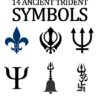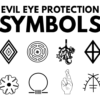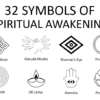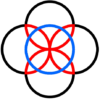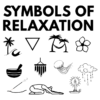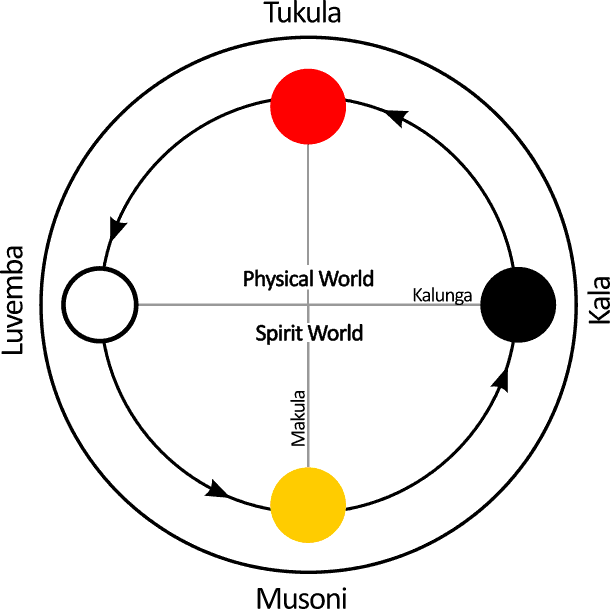
Humans have been using cosmograms for hundreds of years. These drawings depict a cosmology, or theory about the origins of the universe. Cosmograms seek to illustrate where we came from and where we are going. They provide an explanation for life as we know it, offering the comfort of certainty in a confusing world. One of the oldest cosmograms is the Kongo Cosmogram.
In this article, let’s look at the profound spiritual meaning associated with this cosmogram and learn how you can apply it to your own life.
What is the Kongo Cosmogram?
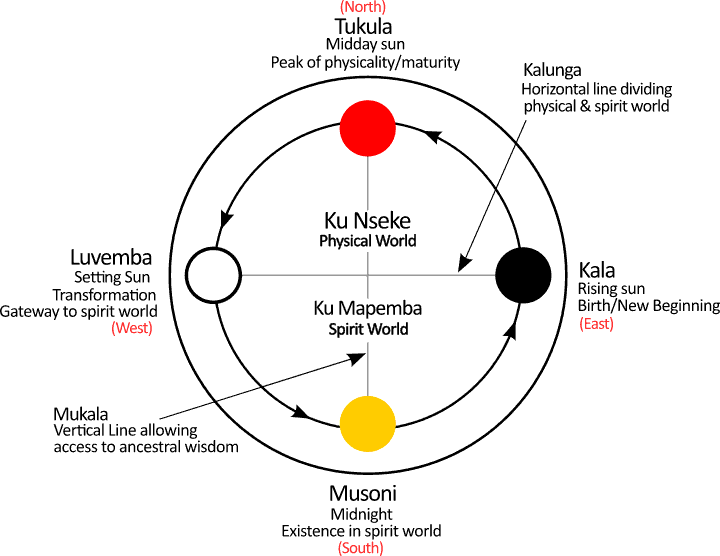
The Kongo Cosmogram (also known as Dikenga or Yowa) is an ancient circular symbol that depicts the cosmology of the BaKongo people, a tribe residing in central Africa and the modern-day Democratic Republic of the Congo. It was used as a sacred prayer symbol and primarily depicts the four important phases of human life based on the movement of the sun. The cosmogram symbolizes eternal life, immortality of the soul, interconnectedness of being, universal balance, divinity, spiritual awakening and magical powers.
The symbol was first recognized in cave drawings throughout the region. Archeologists don’t know exactly how old the drawings are, but many believe that this cosmogram is the oldest geometric shape illustrating the movements of the sun.
Cultural Significance of the Kongo Cosmogram
Regardless of its age, the Kongo Cosmogram holds great meaning for the BaKongo people. It is also integral to other tribes throughout Africa who use similar symbols. Translated from the Kikongo word ‘Dikenga’, the Kongo Cosmogram’s literal meaning is “the turning”. Metaphorically, this turning refers to the cycles of the universe.
The Cosmogram is read counterclockwise, and its circular motion is the ultimate representation of the infinite spiral. Without beginning or end, the cosmogram is the life cycle of the world and all its creatures. It holds divine answers and the key to spiritual enlightenment through knowledge about the process of life, death, and rebirth.
Also called the Yowa, Dikenga illustrates the “Tendwa Nza Congo”—or the four positions of the sun. It is believed that just like the Sun, humans must pass through four positions in our life cycle. These passages are called Dingo-y-Dingo, which means coming and going from the center. By studying the cosmogram, we can understand our relation to it more comprehensively.
Representation of the Spirit & Human World in the Kongo Cosmogram
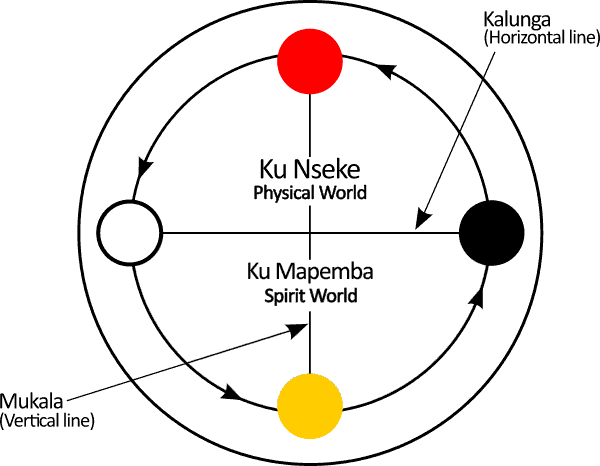
The cosmogram is a circle with an equilateral cross inside, dividing it into four distinct quarters. The vertical line of the cross is known as Mukula and the horizontal line is known as Kalunga.
Makula: Makula (the vertical line) represents growth and maturation. Mukula indicates a deep understanding of existence and ancestral wisdom, which one must gain throughout the life cycle.
Kalunga: Kalunga (horizontal line) represents the barrier between the world of the living and the world of the spirit. The uppermost portion of the cosmogram is located above the horizontal dividing line. This upper half is known as Ku Nseke, the physical world. It is where our bodies and consciousness reside. The lower portion of the cosmogram is located below Kalunga. It is known as Ku Mpemba, the spiritual world. It is where unconscious thoughts and soul processes take place.
Representation of Life Cycle in the Kongo Cosmogram
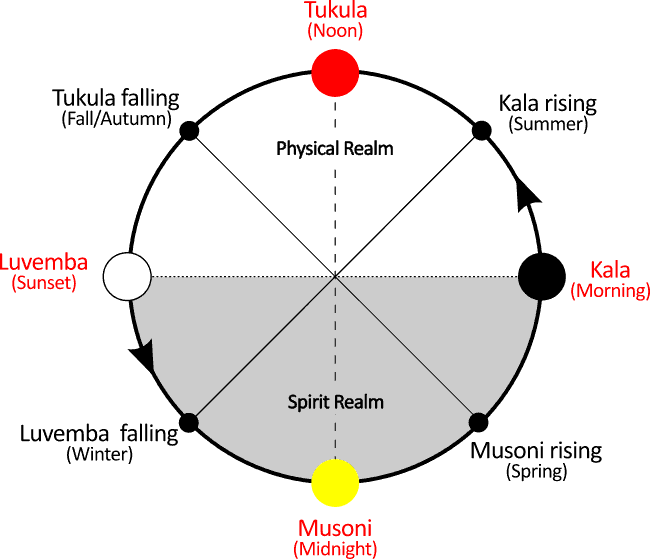
The two main dividing lines also serve to form four distinct quadrants. Each quadrant represents a phase in our life cycle. Each quadrant can further be divided into two phases making it a total of 8 different phases of human existence (as shown in the image above). This includes, Kala, Kala Rising, Tukula, Tukula rising, Luvemba, Luvemba falling, Musoni and Musoni rising.
Out of these phrases, Kala, Kala Rising, Tukula, and Tukula Falling all take place in the physical world of Ku Nseke, the uppermost portion of the cosmogram. Whereas, Luvemba, Luvemba Falling, Musoni, and Musoni Rising are all placed on the lower half of the cosmogram. They happen in Ku Mpemba, the spirit world.
Let’s look at what these phases mean:
Kala: Starting in the east, we have Kala. It is representative of birth, the beginning of the cycle, the sunrise in the east, and the start of all things. It is colored black.
Kala rising: From birth we travel through Kala Rising, representative of summer and the discovery of life.
Tukula: We then arrive at Tukula. This is noon, the middle of life. It is the height of physical prowess and maturity. It represents the north, and is colored red for vitality.
Tukula falling: After Tukula, we pass through Tukula Falling. This symbolizes autumn, when colors begin to fade.
Luvemba: After Tukula Falling, we arrive at Luvemba. Luvemba represents old age, death, the setting sun in the west and end of life cycle. It is colored white.
Luvemba falling: From Luvemba we pass through Luvemba Falling, representative of wintertime. Then, we reach Musoni.
Musoni: Musoni characterizes the south, midnight, the opposite of living vitality in Tukula. It is colored yellow.
Musoni rising: Musoni is the final cycle before we enter Musoni Rising, representative of springtime and the beginning of the new life cycle to be had in yet another Kala.
Spiritual Meanings Associated with the Kongo Cosmogram
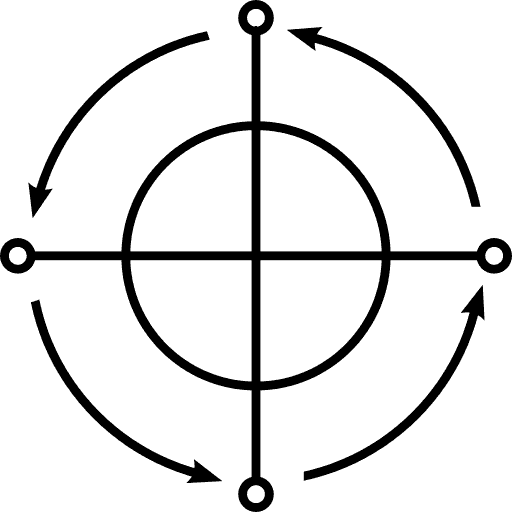
1. Eternal cycle of life
At its core, the Kongo Cosmogram represents the life cycle of humans and the cyclic nature of the universe. We have attempted for millennia to explain our own existence. Where do we come from? Furthermore, why are we born, why do we change and grow, and what happens when we are gone? The Cosmogram offers a perfectly-composed structure which makes sense of our lives.
We come from Musoni, deep in the spirit world. We rise to Kala to be born as babies, entering Tukula at our prime. We then age, falling to Luvemba’s deathly embrace and making our way back to Musoni. In this way we are never-ending, just like the sun. We too have four positions. One of them—death—is invisible. But by making it a part of the cycle, we give it a sense of purpose that negates and balances our fear and confusion.
2. Interconnectedness of being
The Kongo Cosmogram is a reminder that everything is intricately connected and that one cannot exist without the other. Everything in the physical world is connected and in the same way, the physical world is connected to the spirit world.
We are also aligned with each other, because we all pass through the same cycle. Indeed, the cycle for one person cannot happen without contribution from other people—it is only the coupling of humanity which can produce more humans.
Furthermore, humanity is connected to the earth and the larger universe around us. We all follow the same path on different scales, turning in Dikenga throughout eternity. The four seasons, the four positions of the sun, the four directions, and the four stages of the life cycle are mirrored in each other, echoing strongly in the cosmogram’s explanation about the nature of our existence.
3. Balance between opposing polarities
The Kongo Cosmogram represents the polarities in different stages of the life cycle and how they balance each other out. Just as we are most vital at the Tukula stage of our lives, we are least vital after death in Musoni. However, Musoni is when we are most vital spiritually—we cannot complete the cycle and rise once again to Tukula without existing and being reborn in the spiritual realm.
We can equate this to other points in our life as well. For example, the ultimate state of being is joyful happiness. However, that happiness must be borne of sorrow. If we never felt pain, we would not be able to recognize joy. It is only because we experience bad emotions that we are able to experience good ones.
In a similar way, balance between opposing polarities is the basis of existence.
4. Coexistence of dualities and oneness
The cosmogram calls forth the saying, “as above, so below”. This ancient turn of phrase can be taken in this context to mean that the spiritual world mirrors the physical, or that Ku Nseke mirrors Ku Mpemba. They are the inherent dualities in the cosmogram. The cosmogram also symbolizes other dualities such as life and death, creation and destruction, and rebirth and oblivion.
However, the cyclic (circular) nature of the cosmogram also reflects the opposite. It illustrates a progression from oneness, the splitting into dualities, and the eventual regression back to oneness. This merging of opposites to recreate the vast unified energy from which all life flows is essential to maintaining the balance we need to survive.
5. Spiritual awakening
Kalunga and Mukula respectively both represent different aspects of spiritual awakening. Kalunga is the horizontal line dividing the spiritual and physical worlds, or the realms of death and life. We pass endlessly through these phases again and again. It’s a metaphor for the eternal nature of our souls and the transformation, rebirth, and reincarnation that is the natural process for everyone.
Kalunga is often represented by water. In this way, it can be said that the line between living and dead is fluid. You may access wisdom in the spirit world simply by raising your awareness. Mukula (the vertical line) represents the line of knowledge; by crossing it we gain access to a world of understanding and ancestral wisdom.
Both, Kalunga and Makula denote that with enough awareness, you can communicate with and draw energy from the spirit world that will help in your spiritual advancement, manifestation and protection in the physical world.
Similarities with Native American Medicine Wheel
When discussing the Kongo Cosmogram, it’s important to bring up the native American Medicine Wheel. The two come from opposite sides of the world, yet they are so similar they could be designed and drawn by the same person. With two dividing lines and four distinct quadrants, the Medicine Wheel (as shown in the image below) is a near-identical representation of our life cycle, reincarnation, and the spiritual realms.
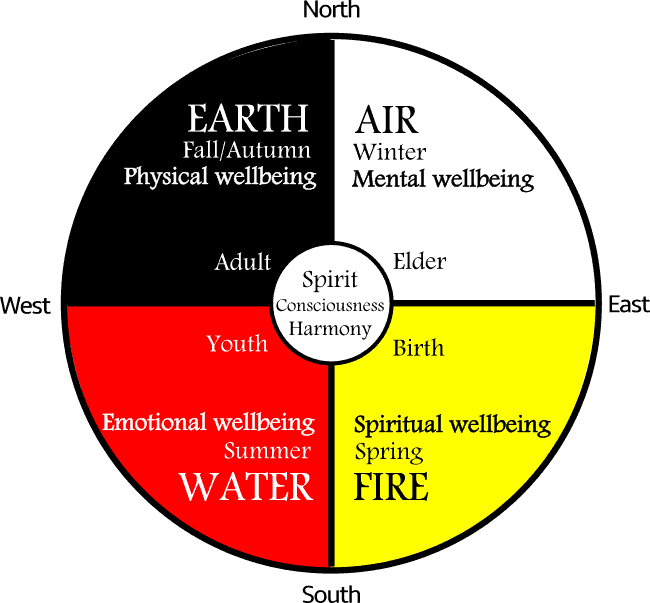
It doesn’t just look like the cosmogram. It acts similarly, too. Both symbols follow the direction of the sun. They both represent the passage of our souls through the life cycle and the connection that we humans have with the earth, the universe, and nature.
Similar to the Kongo cosmogram, the medicine wheel has four quadrants with similar colors (red, yellow, white and black) that symbolize the four directions, the four stages of life, four important virtues (spiritual, emotional, mental and physical), four sacred plants (sweetgrass, tobacco, cedar and sage), four elements, four times of the day (Midnight, Dawn, Noon and Dusk), and the four seasons.
Perhaps the only way the Medicine Wheel differs from the Kongo cosmogram is the fact that it focuses a bit more on the tangible world around us. Where the cosmogram relies heavily on symbolism in the spiritual realm such as reincarnation, awakening, and enlightenment, the Medicine Wheel incorporates physical elements as well.
Conclusion
The Kongo Cosmogram is an ancient symbol, but it still holds great meaning in our lives today. In fact, we can look to it during times when we need spiritual soothing. The cosmogram is a gentle reminder that everything falls in its own place. We needn’t struggle or force things into a state of harmony, for the world is inherently balanced and the wheel will soon turn in the direction it was always meant to.


